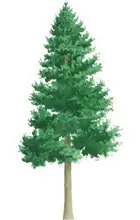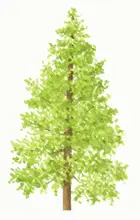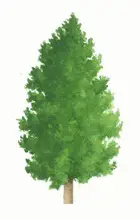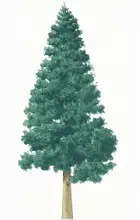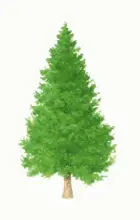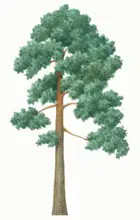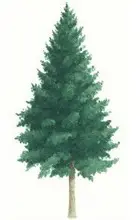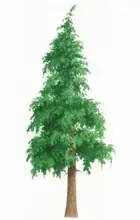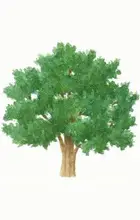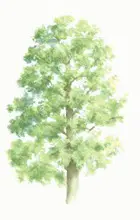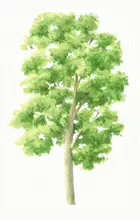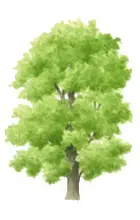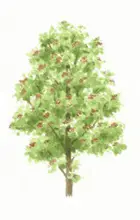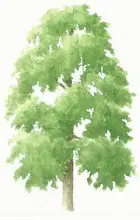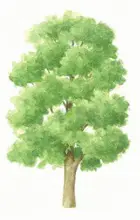From towering giants, to diminutive beauties - Scotland's trees are as diverse as the landscape itself. On these pages you can get to know some of the trees that make up our forests, learn their stories and find out about their many practical uses.
Coniferous trees
Conifers are cone-bearing and often have needle-like leaves. They do well in cold conditions and most are evergreen but some, like larch, are deciduous and drop their needles in winter. They are fast-growing and make up the majority of the trees we grow for timber harvesting.
Corsican pine
This slender, conical tree can reach up to 27 metres tall with horizontal branches. Its needles are long, grouped in pairs and have a distinctive twist. Its fissured, dark greyish-brown bark breaks off easily.
Corsican pine
Douglas fir
The Douglas fir can grow to be very tall indeed, reaching up to 60 metres in Britain. It has soft needles with two grey bands underneath and oval shaped cones that hang downwards. Its bark is reddish-brown, fissured and corky.
Douglas fir
Hybrid larch
The hybrid larch can grow to 40 metres in height. It grows deciduous needles in rosettes on short shoots, and reddish purple flowers which form cylindrical cones with rounded scales. Its grey-brown bark is fissured into regular plates.
Hybrid larch
Lodgepole pine
A thin and narrow-crowned tree which grows to 40-50 metres. It has twisted yellowish-green needles found in pairs that measure 5–8 cm long and cones with prickly scales. The bark is variable but typically red-brown with fine curled flakes.
Lodgepole pine
Noble fir
A handsome conifer which can reach 45 metres in height. It has long upswept bluish-grey needles and large upright cones with downturned feathery bracts. The smooth bark is pale grey to purplish.
Noble fir
Norway spruce
A conically shaped tree reaching up to 40 metres in height. It has long cylindrical brown cones which hang down and pointed mid-green needles standing on tiny pegs. The smooth bark is greyish-brown with a rusty tint.
Norway spruce
Scots pine
Scotland's national tree. It matures to up to 36 metres, and tends to lose its lower branches as it ages. It has brown, egg-shaped cones, in clusters of two to four with a small sharp prickle on each scale. Its twisted blue-green needles are found in pairs. The upper bark is an orange-red, while the lower bark is deeply fissured.
Scots pine
Sitka spruce
The fifth largest conifer, it tends to grow up to 55 metres but can reach 100 metres. Flattened solitary needles and light brown, papery cones hang on drooping branches. The bark is greyish-brown when mature and flakes off in round scales.
Sitka spruce
Western hemlock
This tree has random needles of varying lengths, with green above and white below. Look out for its characteristic drooping and small egg-shaped cones. As it ages, the tree loses its lower branches and its bark becomes deeply furrowed into scaly ridges.
Western hemlock
Yew
A round, densely-branched tree that grows from 15 to 29 metres tall. The light brown bark is thin and scaly, becoming deeply furrowed and breaks away in long flakes. Every part of the tree - except the fleshy seed cap - is poisonous to man and cattle but not to deer or rabbits.
Yew
Broadleaf trees
Broadleaved trees usually have wide leaves that are lost in the autumn, although some, like holly – are evergreen. Because they grow so slowly, timber from broadleaves is known as hardwood.
Ash
These tall, domed trees can reach up to 40 metres in height. The leaves are arranged in pairs whilst the single-winged seeds grow in bunches. The bark starts smooth and greenish-grey before turning grey and fissured with age.
Ash
Beech
Mature beech trees have a dense canopy made up of many branches. Its husks split to release two triangular seeds which can be eaten or roasted to make a type of coffee. The bark is smooth, grey and delicate – making it a popular tree for lovers to carve their initials into.
Beech
Hazel
This tree usually resembles a shrub, but can reach seven metres if left uncut. In October ripe nuts enclosed in leafy bracts appear, whilst in late winter, male flowers form ‘lambs-tail’ catkins. The bark is smooth, shiny brown with conspicuous yellow lenticels and scaly patches.
Hazel
Oak
This broad spreading tree can reach up to 30 metres in Scotland. Most do not produce acorns until they are over 50 years old. The oak’s acorns are carried on long stalks or ‘peduncles’.
Oak
Rowan
This graceful, narrow tree is easy to spot in autumn due to its bright red berries. It has flat heads of cream coloured, heavily scented flowers and smooth, purplish or grey-brown bark.
Rowan
Silver birch
This tree can grow to 24 metres, with spreading lower branches and the rest pointing up. It has triangular leaves and papery, peeling upper bark.
Silver birch
Small-leaved lime
The small-leaved lime has downward arching branches and grows to 35 metres tall. It has sweet smelling flowers which attract bees, other insects and birds including woodpeckers. Its smooth, grey bark cracks with age.
Small-leaved lime
Sweet chestnut
Broadening with age, this tree can reach up to 40 metres in height. It grows long catkins, the remains of which stay attached to the husk until they fall off. Its bark can be recognised from its long diagonal fissures.
Sweet chestnut
Sycamore
This is a broad tree with dense foliage reaching 25 metres. It can be recognised by its winged seeds, set in pairs, that fall like helicopter blades. Its leaves often have ‘tar spots’ caused by the fungus Rhytisma acerinum.
Sycamore
Wild cherry
This tree's scented white flowers are followed by small green cherries, which turn red then purple when ripe. Birds quickly strip the fruit and spread the seeds by dropping or swallowing them. The wild cherry has smooth purplish-brown bark.
Wild cherry
Learn more

